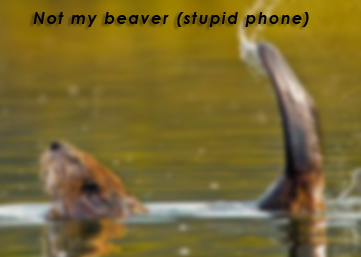It’s probably common knowledge that beavers slap the water with their tails as a warning about – or an attempt to startle – potential predators. They also tend to swim with their heads slightly above water but with their bodies slightly submerged.
So, you may be ask, why are you – a native Texan living in the heart of a beaver-impoverished state – giving this random lecture about the creature’s behavior? Simply this: I watched a beaver swim in the creek behind our house last night. I have never heard of a beaver sighting in this area, much less seen one myself, and I’m still trying to wrap my head around the fact that they are indeed living in our neighborhood.
We came home around dusk after eating out with friends, and there were some significant thunderheads building up in the north, so I walking into the back yard to observe them. Our weather was calm and there was still enough light to see the creek, so I stood at the back fence and looked down at the water, about twenty feet away.
I saw a shape moving in the water and my first thought was “that’s the biggest catfish I’ve ever seen in the creek!” My second thought was, “wait…what? We don’t have catfish in the creek.” The shape appeared to be 2-3′ long, trailing something wide. I mentally cycled through some possibilities, trying to place it in a logical context. I knew there were nutria around the lake, but those are basically big rats with long skinny tails, and that didn’t fit the profile of what I was watching.
The shape continued to swim slowly down the middle of the stream, and I figured I should attempt to get a photo or video to prove my sanity, even though the fading light made it doubtful that my aging phone’s camera would capture anything recognizable. And fail it did, although perhaps not entirely of its own fault. What I managed to record was approximately five seconds of the ground.*
 My view of the animal was blocked by a tree on the creek bank, but I expected it to come into sight in a clearing a few feet down the stream. It didn’t, so I decided it had doubled back. I moved back down the fence line and sure enough, it was swimming the other direction. But my movement apparently caught its attention and its reaction confirmed that what I was watching was indeed a beaver. With a loud slap of the water’s surface with its tail, it disappeared and I did not spot it again.
My view of the animal was blocked by a tree on the creek bank, but I expected it to come into sight in a clearing a few feet down the stream. It didn’t, so I decided it had doubled back. I moved back down the fence line and sure enough, it was swimming the other direction. But my movement apparently caught its attention and its reaction confirmed that what I was watching was indeed a beaver. With a loud slap of the water’s surface with its tail, it disappeared and I did not spot it again.
I described the encounter to MLB and she was initially skeptical, but after an extended conversation with Mr. Google, she confirmed that beavers are present pretty much throughout Texas, with the exception of the western part of the state. We also learned that they prefer still water, but Pecan Creek is very slow-moving with limpid pools forming at various bends, so it would not necessarily be a beaver-unfriendly environment. And, finally, they are most active right around dusk and dawn.
I realize that some of you live in areas where beavers are plentiful, but for me, this was akin to spotting a cheetah in our back yard. The variety of local wildlife continues to be a constant source of amazement and pleasure.
Have you ever encountered unexpected wildlife in your neighborhood? Tell us about it in the comments!
*Some of the fotografic failure was the fone’s fault. You may have heard about the battery-related slowdowns in old iPhone models, and my 6s is dealing with that now. The camera is so slow to respond that when I tapped the record button and nothing happened, I hit it again. That resulted in my turning off the video instead of turning it on. Rinse and repeat, and the result is intriguing moving images of…dirt.
Discover more from The Fire Ant Gazette
Subscribe to get the latest posts sent to your email.
